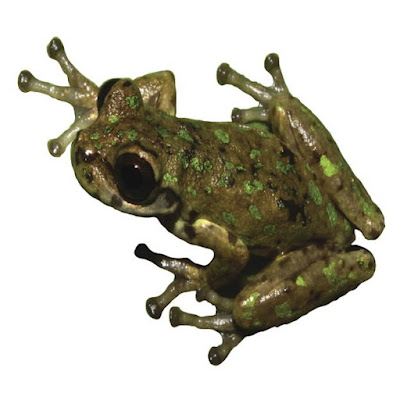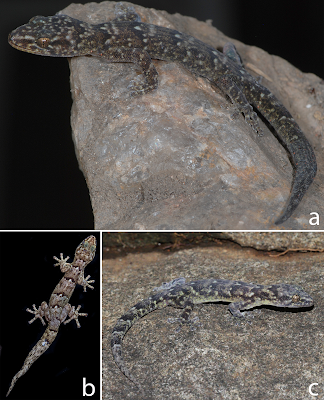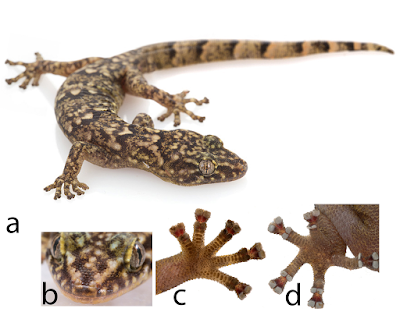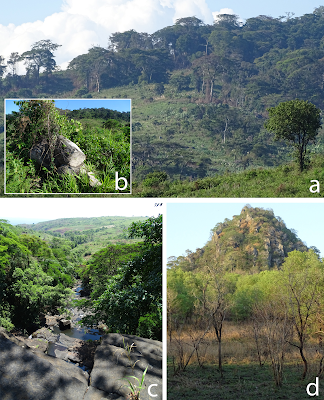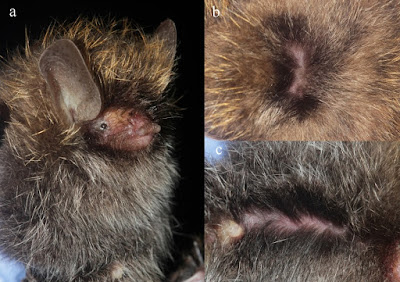[Most Recent Entries] [Calendar View]
Saturday, September 30th, 2017
| Time | Event | ||||
| 3:12p | [Herpetology • 2017] A Multilocus Phylogeny of the Genus Sarcohyla (Anura: Hylidae), and An Investigation of Species Boundaries Using Statistical Species Delimitation
Highlights • We present a phylogenetic analysis of 17 species of the genus Sarcohyla using data from two mitochondrial (ND1 and 12s) and three nuclear genes (Rag-1, Rhod, and POMc). • The widely distributed species S. bistincta is a complex of at least three species. • Two undescribed species exists in the group. • The species S. ephemera is a junior synonym of S. calthula. Abstract The genus Sarcohyla is composed by 24 species endemic to México. Despite the large number of phylogenetic studies focusing on the family Hylidae, the relationships among the species of Sarcohyla are still poorly known, and the scarce numbers of specimens and tissue samples available for some of the species has hampered an appropriate phylogenetic analysis. We present the most comprehensive molecular phylogenetic study of Sarcohyla to date. We included 17 species of the genus Sarcohyla using data from two mitochondrial (ND1 and 12S) and three nuclear genes (Rag-1, Rhod, and POMc). We performed phylogenetic analyses using Bayesian inference, and the absence of conflicts with strong support between the separate gene trees indicates that incomplete lineage sorting and/or introgressive hybridization are negligible. A coalescent-based species-tree analysis of the four independent loci (three nuclear genes + mtDNA) mostly supports the same species-level relationships as the analysis of the concatenated data. By including new samples from additional species and localities, we find that: (1) the widely distributed species S. bistincta is a complex of at least three species, (2) another undescribed species exists in the group, (3) the species S. ephemera is not valid and it corresponds to a junior synonym of S. calthula. In addition, we conducted marginal likelihood estimation and used Bayes factors to test alternative species delimitation models for S. bistincta, the most widespread nominal species in the group. Our findings support three independent lineages of S. bistincta group, which are paraphyletic with respect to S. pentheter and S. calthula. Keywords: Systematics, Molecular phylogeny, Hylidae, Sarcohyla, Mexico Our analysis revealed several taxonomic problems in Sarcohyla. Of the 17 species included in the analysis, three species may represent junior synonyms of other taxa (S. arborescandens, S. ephemera, and S. miahuatlanensis), and another two appear to represent multiple species (S. bistincta and S. thorectes). These problems may be explained, at least in part, by the absence of morphological autapomorphies in many species of Sarcohyla (which can therefore only be distinguished by unique combinations of traits), and to the scarcity of informative characters and high levels of homoplasy in the group (Duellman, 2001). Although external morphology usually is the first evidence for species recognition, molecular evidence and implementation of modern species delimitation methods based on coalescence theory are needed to identify/corroborate species (i.e., Grummer et al., 2014). Accurate species delimitation and phylogeny reconstruction in Sarcohyla is important to infer the historical biogeography of the highlands of Mexico and specially to develop accurate conservation plans for this group of frogs. For instance, underestimation of species diversity can impact the selection of the areas that will be conserved. Further fieldwork is needed to obtain the samples for a complete, fully resolved, well-supported phylogeny for the genus. Itzue W. Caviedes Solis and Adrián Nieto-Montes de Oca. 2017. A Multilocus Phylogeny of the Genus Sarcohyla (Anura: Hylidae), and An Investigation of Species Boundaries Using Statistical Species Delimitation. Molecular Phylogenetics and Evolution. In Press. DOI: 10.1016/j.ympev.2017.09.010 | ||||
| 3:38p | [Herpetology • 2017] Afroedura gorongosa • A New Flat Gecko (Squamata: Gekkonidae: Afroedura) from Mount Gorongosa, Mozambique
  Abstract A new species of flat gecko, Afroedura gorongosa sp. nov., is described from Gorongosa National Park, Sofala Province, central Mozambique. The new species is morphologically similar to A. transvaalica and A. loveridgei, from both of which it is genetically distinct (15–17% divergence; 400 bp of 16S rRNA). Morphologically it can be distinguished from both species by having fewer midbody scale rows (97–101) and a higher number of precloacal pores in males (8–13). The type series was collected on the western flanks of Mount Gorongosa (900 and 1100 m a.s.l.) in comparatively cool and moist microclimates, where it is threatened by illegal deforestation. Additional material was collected as low as 212 m a.s.l. on an inselberg near Mount Gorongosa. The new discovery adds to the growing number of endemic montane reptiles discovered in Mozambique in recent years, and highlights the need for a national conservation assessment of the country’s herpetofauna and continued protection of the Mount Gorongosa region. Keywords: Reptilia, Afroedura gorongosa sp. nov.; Afroedura loveridgei; Afroedura transvaalica; biodiversity; endemism; lizards Etymology. The specific name refers to Mount Gorongosa and Gorongosa National Park in Central Mozambique, to which the species is endemic. We suggest Gorongosa Flat Gecko is a suitable common name. Afroedura, based on Oedura, is feminine and the specific epithet is treated as a noun in apposition. William R. Branch , Jennifer A. Guyton, Andreas Schmitz, Michael F. Barej, Piotr Naskrecki, Harith Farooq, Luke Verburgt and Mark-Oliver Rödel. 2017. Description of A New Flat Gecko (Squamata: Gekkonidae: Afroedura) from Mount Gorongosa, Mozambique. Zootaxa. 4324(1); 142–160. DOI: 10.11646/zootaxa.4324.1.8 ResearchGate.net/publication/320043814_DResumo: Aqui descreve-se uma nova espécie de osga, Afroedura gorongosa sp. nov., do Parque Nacional da Gorongosa, na Provín-cia de Sofala, centro de Moçambique. Do ponto de vista morfológico, a nova espécie assemelha-se às osgas A. transvaa-lica e A. loveridgei, sendo geneticamente distinta de ambas (divergência de 15–17%; 400 bp de 16S rRNA). Distingue-se morfologicamente de ambas as espécies por ter um número inferior de fileiras de escamas na secção mediana (97–101) e um número superior de poros pré-cloacal nos machos (8–13). A série-tipo foi recolhida nos flancos ocidentais da Serra da Gorongosa (900 e 1100 m a.s.l.), em microclimas relativamente mais frios e húmidos, onde se encontra ameaçada pela desflorestação ilegal. Estas osgas foram também recolhidas à altitude de 212 m a.s.l., num inselberg e próximo da Serra da Gorongosa. A nova descoberta junta-se ao crescente número de répteis endémicos de montanha descobertos em Moçambique nos últimos anos, e realça a necessidade de uma avaliação da conservação da herpetofauna do país a nível nacional, bem como a proteção da região do Monte Gorongosa. Palavras-chave: Afroedura gorongosa sp. nov.; Afroedura loveridgei; Afroedura transvaalica; biodiversidade; endemis-mo; lagartos | ||||
| 4:54p | [Mammalogy • 2017] Murina hkakaboraziensis • A New Species of Murina (Chiroptera: Vespertilionidae) from the Hkakabo Razi Landscape, Sub-Himalayan Forests of northern Myanmar
Abstract A new species of Murina of the suilla-type is described from the Hkakabo Razi Landscape, Kachin, Upper Myanmar, an area that is currently being nominated as a World Heritage Site. The new species is a small vespertilionid, with a forearm length of 29.6 mm, and is very similar to M. kontumensis, which was recently described from Vietnam. However, it is distinguishable by a combination of external and craniodental morphology and genetics. The DNA Barcode reveals that the new species clusters sisterly to M. kontumensis but with a genetic distance of 11.5%. A single known specimen of the new species was collected from a lowland forest area in the plains of the Hkakabo Razi landscape, south-eastern Himalaya. Additional information on ecology, echolocation, and conservation are included. The high cryptic diversity of the genus Murina in Southeast Asia, as well as the Hkakabo Razi Landscape being a bat diversity hotspot, is highlighted. Keywords: Mammalia, cryptic species, Hkakabo Razi, Myanmar, new species, Southeast Asia
Murina hkakaboraziensis sp. nov. Etymology. The species is named after the Hkakabo Razi Landscape, where the only known specimen was collected. The proposed English name is ‘Hkakabo Razi Tube-nosed Bat’ Ecology and distribution. The new species, M. hkakaboraziensis sp. nov., was collected in a mist net set at the edge of a lowland semi-evergreen forest at the transition zone to an open space grassland, which undergoes an annual burn (Fig. 5). The new species was the only bat captured in the mist net. However, on the same night, four other insectivorous bats, Rhinolophus affinis, R. pusillus, Aselliscus stoliczkanus and Hipposideros pomona were captured in nearby mist nets and harp traps. Four other vespertilionids, M. cyclotis, M. feae, M. cf. eleryi, Kerivoula hardwickii, and K. furva were also captured in the same area on other nights. Currently, the new species is only known from the holotype collected from the type locality in the Hkakabo Razi Landscape, Kachin, northern Myanmar. Discussion: The discovery of Murina hkakaboraziensis sp. nov., as well as a recently described Kerivoula furva (Kuo et al. 2017), indicates that the Hkakabo Razi Landscape is extremely understudied in terms of bats. Based only on a single scientific expedition in 2016, 37 species of bats were recorded from HRL (P. Soisook, unpublished data) representing approximately 40% of bats in Myanmar. Nevertheless, the 2016 expedition focused only on a limited geographical area and elevation of the HRL. Future surveys to cover the variety of habitats, particularly at the higher elevations, would be of interest. The vespertilionid community in the HRL appears to be a geographical connection and a unique mix of species those found widespread in the Indochinese Region (e.g. M. cyclotis, M. feae, M. cf. eleryi, K. kachinensis, K. hardwickii, and K. furva), and those from the Indian Region (e.g. M. cf. jaintiana, M. cf. pluvialis). It indicates the importance of primary forests, and ongoing biogeographical processes of the HRL, underlining the significance of Myanmar’s endeavour to nominate the area as a Natural World Heritage Site. Pipat Soisook, Win Naing Thaw, Myint Kyaw, Sai Sein Lin Oo, Awatsaya Pimsai, Marcela Suarez-Rubio and Swen C. Renner. 2017. A New Species of Murina (Chiroptera: Vespertilionidae) from sub-Himalayan Forests of northern Myanmar. Zootaxa. 4320(1); 159–172. DOI: 10.11646/zootaxa.4320.1.9 Hao-Chih Kuo, Pipat Soisook, Ying-Yi Ho, Gabor Csorba, Chun-Neng Wang and Stephen J. Rossiter. 2017. A Taxonomic Revision of the Kerivoula hardwickii complex (Chiroptera: Vespertilionidae) with the Description of A New Species. Acta Chiropterologica. 19(1); 19-39. DOI: 10.3161/15081109ACC2017.19.1.002 |
| << Previous Day |
2017/09/30 [Calendar] |
Next Day >> |
